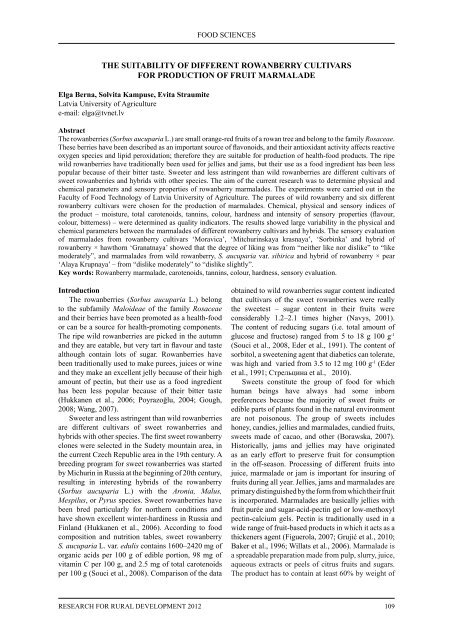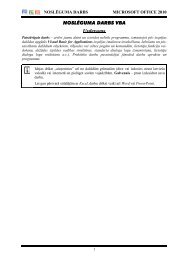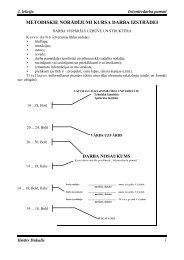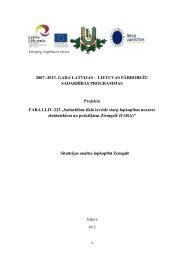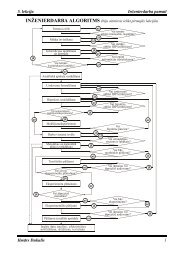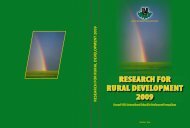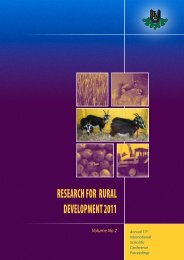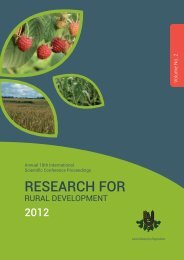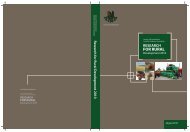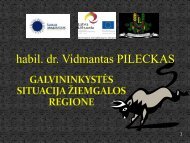LATVIA UNIVERSITY OF AGRICULTURE - Latvijas ...
LATVIA UNIVERSITY OF AGRICULTURE - Latvijas ...
LATVIA UNIVERSITY OF AGRICULTURE - Latvijas ...
- No tags were found...
Create successful ePaper yourself
Turn your PDF publications into a flip-book with our unique Google optimized e-Paper software.
FOOD SCIENCESThe suitability of different ROWANBERRY CULTIVARSfor production of fruit marmaladeElga Berna, Solvita Kampuse, Evita StraumiteLatvia University of Agriculturee-mail: elga@tvnet.lvAbstractThe rowanberries (Sorbus aucuparia L.) are small orange-red fruits of a rowan tree and belong to the family Rosaceae.These berries have been described as an important source of flavonoids, and their antioxidant activity affects reactiveoxygen species and lipid peroxidation; therefore they are suitable for production of health-food products. The ripewild rowanberries have traditionally been used for jellies and jams, but their use as a food ingredient has been lesspopular because of their bitter taste. Sweeter and less astringent than wild rowanberries are different cultivars ofsweet rowanberries and hybrids with other species. The aim of the current research was to determine physical andchemical parameters and sensory properties of rowanberry marmalades. The experiments were carried out in theFaculty of Food Technology of Latvia University of Agriculture. The purees of wild rowanberry and six differentrowanberry cultivars were chosen for the production of marmalades. Chemical, physical and sensory indices ofthe product – moisture, total carotenoids, tannins, colour, hardness and intensity of sensory properties (flavour,colour, bitterness) – were determined as quality indicators. The results showed large variability in the physical andchemical parameters between the marmalades of different rowanberry cultivars and hybrids. The sensory evaluationof marmalades from rowanberry cultivars ‘Moravica’, ‘Mitchurinskaya krasnaya’, ‘Sorbinka’ and hybrid ofrowanberry × hawthorn ‘Granatnaya’ showed that the degree of liking was from “neither like nor dislike” to “likemoderately”, and marmalades from wild rowanberry, S. aucuparia var. sibirica and hybrid of rowanberry × pear‘Alaya Krupnaya’ – from “dislike moderately” to “dislike slightly”.Key words: Rowanberry marmalade, carotenoids, tannins, colour, hardness, sensory evaluation.IntroductionThe rowanberries (Sorbus aucuparia L.) belongto the subfamily Maloideae of the family Rosaceaeand their berries have been promoted as a health-foodor can be a source for health-promoting components.The ripe wild rowanberries are picked in the autumnand they are eatable, but very tart in flavour and tastealthough contain lots of sugar. Rowanberries havebeen traditionally used to make purees, juices or wineand they make an excellent jelly because of their highamount of pectin, but their use as a food ingredienthas been less popular because of their bitter taste(Hukkanen et al., 2006; Poyrazoğlu, 2004; Gough,2008; Wang, 2007).Sweeter and less astringent than wild rowanberriesare different cultivars of sweet rowanberries andhybrids with other species. The first sweet rowanberryclones were selected in the Sudety mountain area, inthe current Czech Republic area in the 19th century. Abreeding program for sweet rowanberries was startedby Michurin in Russia at the beginning of 20th century,resulting in interesting hybrids of the rowanberry(Sorbus aucuparia L.) with the Aronia, Malus,Mespilus, or Pyrus species. Sweet rowanberries havebeen bred particularly for northern conditions andhave shown excellent winter-hardiness in Russia andFinland (Hukkanen et al., 2006). According to foodcomposition and nutrition tables, sweet rowanberryS. aucuparia L. var. edulis contains 1600–2420 mg oforganic acids per 100 g of edible portion, 98 mg ofvitamin C per 100 g, and 2.5 mg of total carotenoidsper 100 g (Souci et al., 2008). Comparison of the dataobtained to wild rowanberries sugar content indicatedthat cultivars of the sweet rowanberries were reallythe sweetest – sugar content in their fruits wereconsiderably 1.2–2.1 times higher (Navys, 2001).The content of reducing sugars (i.e. total amount ofglucose and fructose) ranged from 5 to 18 g 100 g -1(Souci et al., 2008, Eder et al., 1991). The content ofsorbitol, a sweetening agent that diabetics can tolerate,was high and varied from 3.5 to 12 mg 100 g -1 (Ederet al., 1991; Стрельцина et al., 2010).Sweets constitute the group of food for whichhuman beings have always had some inbornpreferences because the majority of sweet fruits oredible parts of plants found in the natural environmentare not poisonous. The group of sweets includeshoney, candies, jellies and marmalades, candied fruits,sweets made of cacao, and other (Borawska, 2007).Historically, jams and jellies may have originatedas an early effort to preserve fruit for consumptionin the off-season. Processing of different fruits intojuice, marmalade or jam is important for insuring offruits during all year. Jellies, jams and marmalades areprimary distinguished by the form from which their fruitis incorporated. Marmalades are basically jellies withfruit purée and sugar-acid-pectin gel or low-methoxylpectin-calcium gels. Pectin is traditionally used in awide range of fruit-based products in which it acts as athickeners agent (Figuerola, 2007; Grujić et al., 2010;Baker et al., 1996; Willats et al., 2006). Marmalade isa spreadable preparation made from pulp, slurry, juice,aqueous extracts or peels of citrus fruits and sugars.The product has to contain at least 60% by weight ofResearch for Rural Development 2012109


